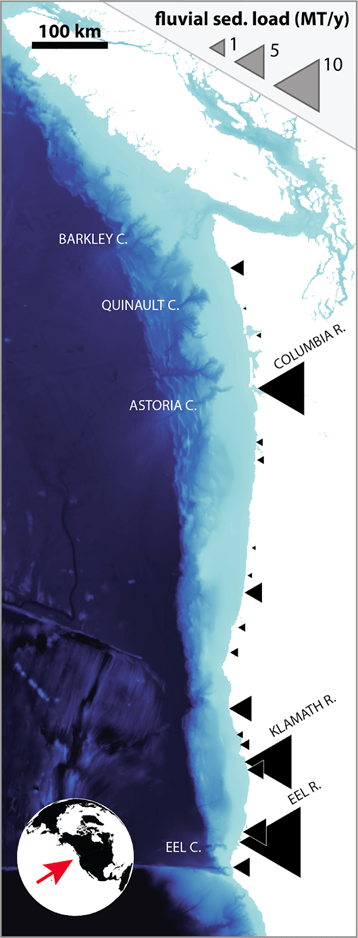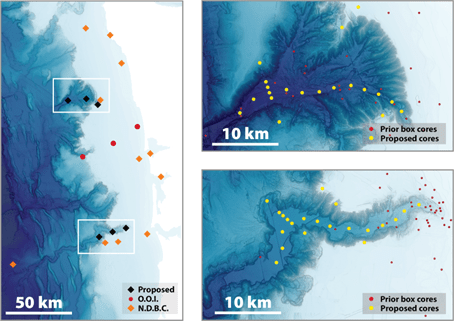Submarine canyons are present along nearly every continental margin and are the sites of globally significant ocean mixing, sediment transport, and nutrient exchange between the coastal and abyssal environment. Earth’s submarine canyons are maintained by density-driven flows of water and sediment, but the mechanisms that trigger flows—and their downslope flow evolution—are still not comprehensively understood. Recent observational studies have shown that 1) there is a broad spectrum of sediment gravity flow behavior that was not previously recognized, 2) significant resuspension events are triggered by a wide variety of oceanic processes, and 3) turbidites and mass transport deposits are found in modern canyon stratigraphy. Each of these findings challenges the conceptual framework that most canyons are “inactive” during today’s sea level highstand. 
This study examines the frequency, synchronicity, and extent of sediment gravity flows through two Cascadia canyons which are morphologically distinct yet share the same fluvial source. The specific targets of this study are to assess the conditions necessary to trigger sediment gravity flows via oceanic processes, evaluate the capacity of flows to evolve from small dilute flows to powerful erosive flows, and identify the characteristic depositional signatures of ocean-driven events. Our methods integrate a large, multi-canyon instrument deployment, targeted seabed coring survey, and hydrodynamic model of sediment gravity flows. The contrasting canyons in this study, Astoria and Quinault, allow us to compare how processes are mediated by canyon morphology, addressing: seafloor sediment loading from fluvial sources, triggering of flows by the bathymetric focusing of wave and current energy, and synchronous downslope transport across distant canyon systems. We predict that sedimentary deposits in relatively deep-water environments can be created via oceanic triggering, and aim to place quantitative constraints on the downslope limit of such flows. We also predict that processes in divergent canyon morphologies result in deposits that are both synchronously and asynchronously emplaced at depth. Not only will this study move forward theoretical knowledge of canyon function and gravity flow propagation, it will also provide a landmark observational dataset for the Cascadia margin.
The experimental plan for this project studies two distinct canyons to explore how processes and canyon morphology interact to create unique transport systems. By combining time-series data from project-deployed sensors with OOI Coastal Endurance and NOAA Buoy data, seafloor sedimentology, and turbidity current modeling, we assess sediment gravity flow triggers and propagation in highstand canyon environments. Our hypotheses are:
1) Sediment gravity flows are oceanically triggered both shallow and deep.
Sediment transport events and canyon-confined failures that could evolve into sediment gravity flows, and these can be initiated both in the canyon head and/or lower in the canyon system.
2) Remobilization during storms causes “synchronous” sediment gravity flows.
Following from Hypothesis 1, we address when oceanic processes trigger sediment gravity flows, and whether they may be synchronous across multiple canyon systems.
3) Ocean-process triggered gravity flows can achieve autosuspension and long runout.
The experimental and analytical approaches will allow us to constrain the maximum observed and modeled extent of gravity flows in each canyon system.
By synthesizing the results of the hypothesis above, this study will address whether gravity flows sourced in the head and upper thalweg of canyons have the potential to reach water depths where the turbidite record has been interpreted for seismic recurrence intervals. This will move the field of sediment dynamics and shallow stratigraphic interpretation towards a more rigorous understanding of canyon functioning and turbidite sources.

Bathymetry and key data collection sites for the two canyons in this study.
This material is based upon work supported by the National Science Foundation under Grant No. OCE-2147983
